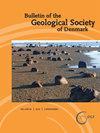Early Cretaceous stratigraphic and basinal evolution of the Danish Central Graben: a review
IF 1
4区 地球科学
Q2 Earth and Planetary Sciences
引用次数: 1
Abstract
An integrated seismic–stratigraphic study of the Lower Cretaceous Cromer Knoll Group was undertaken as part of a recent comprehensive analysis of the Upper Jurassic – lowermost Cretaceous petroleum system in the Danish Central Graben. This study of the basal group of the post-rift package yielded an updated regional assessment of the distribution of the Valhall, Tuxen, Sola and Rødby Formations. This is documented by four high resolution isochore maps (presented here) that record temporal shifts in subsidence patterns from the latest Ryazanian to the earliest Cenomanian. The distribution and thickness variation of the mud-dominated Valhall Formation (latest Ryazanian – early Hauterivian) at the base of the group attests to the progressive fill of inherited syn-rift morphology. The dominant depositional theme is thus ponding in, and onlap from, the main inherited depocentres, although growth faults and incipient inversion locally controlled stratigraphic architecture, and new depocentres were initiated in the east of the graben (Ål and Outer Rough Basins). The isochores for the succeeding, increasingly chalk-rich Tuxen, Sola and Rødby Formations (Hauterivian – earliest Cenomanian) document the regional weakening of syn-rift patterns but emphasize the shift in sedimentation patterns controlled by accelerating inversion activity in the east (Adda–Tyra area, Søgne Basin) and increased local subsidence. The latter sometimes coincided with syn-rift depocentres, such as the Roar Basin and the Arne-Elin Graben, but was also significant in the new Early Cretaceous depocentres in the west of the graben, particularly the Outer Rough Basin. The evolution of the Early Cretaceous basin recorded by this dataset reveals significant shifts in the subsidence pattern in the late Valanginian – early Hauterivian, in large part due to early inversion in the east, and during the late Aptian – early Albian when subsidence was focussed in central and western sub-basins, probably locally due to salt withdrawal. These events, in combination with sea-level change, had implications for the accumulation and preservation of Barremian and early Aptian reservoir chalks.丹麦中央地堑早白垩世地层与盆地演化综述
作为最近对丹麦中央地堑上侏罗纪-下白垩纪石油系统综合分析的一部分,对下白垩纪克罗默-诺尔群进行了综合地震-地层研究。这项对裂谷后包基底群的研究对瓦尔霍尔组、Tuxen组、Sola组和Rødby组的分布进行了最新的区域评估。这是由四张高分辨率等容线图(此处提供)记录的,这些图记录了从最新梁赞阶到最早Cenomanian阶沉降模式的时间变化。该群底部以泥浆为主的瓦尔霍尔组(最新梁扎阶-早期豪特里夫阶)的分布和厚度变化证明了继承的同裂谷形态的渐进填充。因此,尽管生长断层和早期反转局部控制了地层结构,但主要的沉积主题是在主要继承的沉积中心内积水和上覆,新的沉积中心在地堑东部(Ål和外粗糙盆地)开始。随后的、白垩含量越来越丰富的Tuxen、Sola和Rødby地层(豪特里夫阶-最早的Cenomanian阶)的等容线记录了同裂谷模式的区域弱化,但强调了东部(Adda–Tyra地区,Søgne盆地)反转活动加速和局部沉降增加所控制的沉积模式的变化。后者有时与同裂谷沉积中心重合,如Roar盆地和Arne Elin地堑,但在地堑西部新的早白垩世沉积中心也很重要,尤其是外Rough盆地。该数据集记录的早白垩世盆地的演化揭示了瓦朗吉阶晚期-豪特里阶早期沉降模式的显著变化,这在很大程度上是由于东部的早期反转,而在阿普第阶晚期-阿尔比阶早期,沉降集中在中部和西部子盆地,可能是局部由于盐的提取。这些事件,再加上海平面变化,对Barremian和早期Aptian储层白垩的积累和保存产生了影响。
本文章由计算机程序翻译,如有差异,请以英文原文为准。
求助全文
约1分钟内获得全文
求助全文
来源期刊

Bulletin of the Geological Society of Denmark
GEOSCIENCES, MULTIDISCIPLINARY-
CiteScore
2.80
自引率
16.70%
发文量
28
审稿时长
>12 weeks
期刊介绍:
The Bulletin publishes contributions of international interest in all fields of geological sciences on results of new work on material from Denmark, the Faroes and Greenland. Contributions based on other material may also be submitted to the Bulletin if the subject is of relevance for the geology of the area of primary interest.
 求助内容:
求助内容: 应助结果提醒方式:
应助结果提醒方式:


